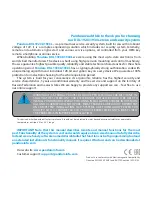
7
ITI/North American Sensor Carbon Monoxide Alarm Installation Instructions
Introducing the GE
Security CO Alarm
Your GE Security Carbon Monoxide Alarm is an effective product for detecting the presence of carbon monoxide
(CO) by continuously monitoring for CO in your home.
What is CO?
Carbon monoxide is a dangerous and poisonous gas produced by the incomplete combustion of fuels such as natu-
ral gas, propane, heating oil, kerosene, coal, gasoline, or wood. The incomplete combustion of fuel can occur in a
device such as a furnace, boiler, room or water heater, stove, grill, or any gas-powered vehicle or engine. Although
many combustion products can cause discomfort and adverse health effects, it is CO that presents the greatest
threat.
Correct operation of fuel burning equipment requires two key conditions. There must be,
1.
an adequate air supply to promote complete combustion.
2.
proper venting of combustion products from the furnace through a chimney, vent, or duct.
CO has no odor or taste and cannot be seen. Exposure to CO prohibits the blood from transporting oxygen through-
out the body; in any enclosed space (home or office), even brief exposure can lead to brain damage or death.
Sources of CO
CO can be produced by any of the following sources: wood stove; wood or gas fireplace; automobile exhaust; gas
water heater; gas or kerosene heater; gas or oil furnace; gas appliances; clogged chimney; cigarette smoke.
Causes of CO
•
Equipment problems due to defect or poor maintenance.
•
Collapsed or blocked chimneys and flues; also dislodged, disconnected, or damaged vents.
•
Downdrafts in chimney or flue; long, indirect flue runs; also improper location of flue exhaust.
•
Improper installation or operation of fuel burning equipment, chimneys, or vents.
•
Inadequate exhaust for space heaters and appliances.
Symptoms of CO
Poisoning
CO is odorless, colorless, tasteless, and extremely toxic. When inhaled, CO produces an effect known as chemical
asphyxiation. When exposed to CO, the body is quickly affected by oxygen starvation. The following symptoms
are related to CO poisoning and should be discussed with each member of the home.
Symptoms of Extreme Exposure Include:
Unconsciousness, convulsions, cardiorespiratory failure, or death.
Symptoms of Medium Exposure Include:
Severe throbbing headache, drowsiness, confusion, vomiting, or increased heart rate.
Symptoms of Mild Exposure Include:
Slight headache, nausea, fatigue, or flu-like symptoms.
What if the Alarm
Sounds?
Your CO alarm emits a loud, continuous tone when hazardous levels of CO are detected in the home. If the alarm
sounds, respond with the following actions:
If Symptoms of CO Poisoning Exist
1.
If family members experience symptoms of CO poisoning — headache, nausea, drowsiness — evacuate the
home immediately and call 911 or other emergency services from an alternate location.
2.
Ensure that all family members are present and accounted for.
Do not
re-enter until the home has been prop-
erly ventilated and the source of CO corrected by the fire department or a qualified technician.
•
After the source of CO has been determined and the problem corrected, reset your CO alarm by pressing the
TEST/RESET button (see
Maintaining the Alarm and Using the Test/Reset Function
section).
If No Symptoms of CO Poisoning Exist
1.
If no symptoms of CO poisoning exist, press the TEST/RESET button on the alarm and ventilate the home
immediately by opening outside leading doors and windows. Turn off all fuel-burning appliances and contact a
utility company representative to inspect your home prior to restarting such appliances.
This device will only sound an alarm if CO is detected at the alarm sensor
only. If not responded to, CO may be present in other areas of the home.
Warning
!


























